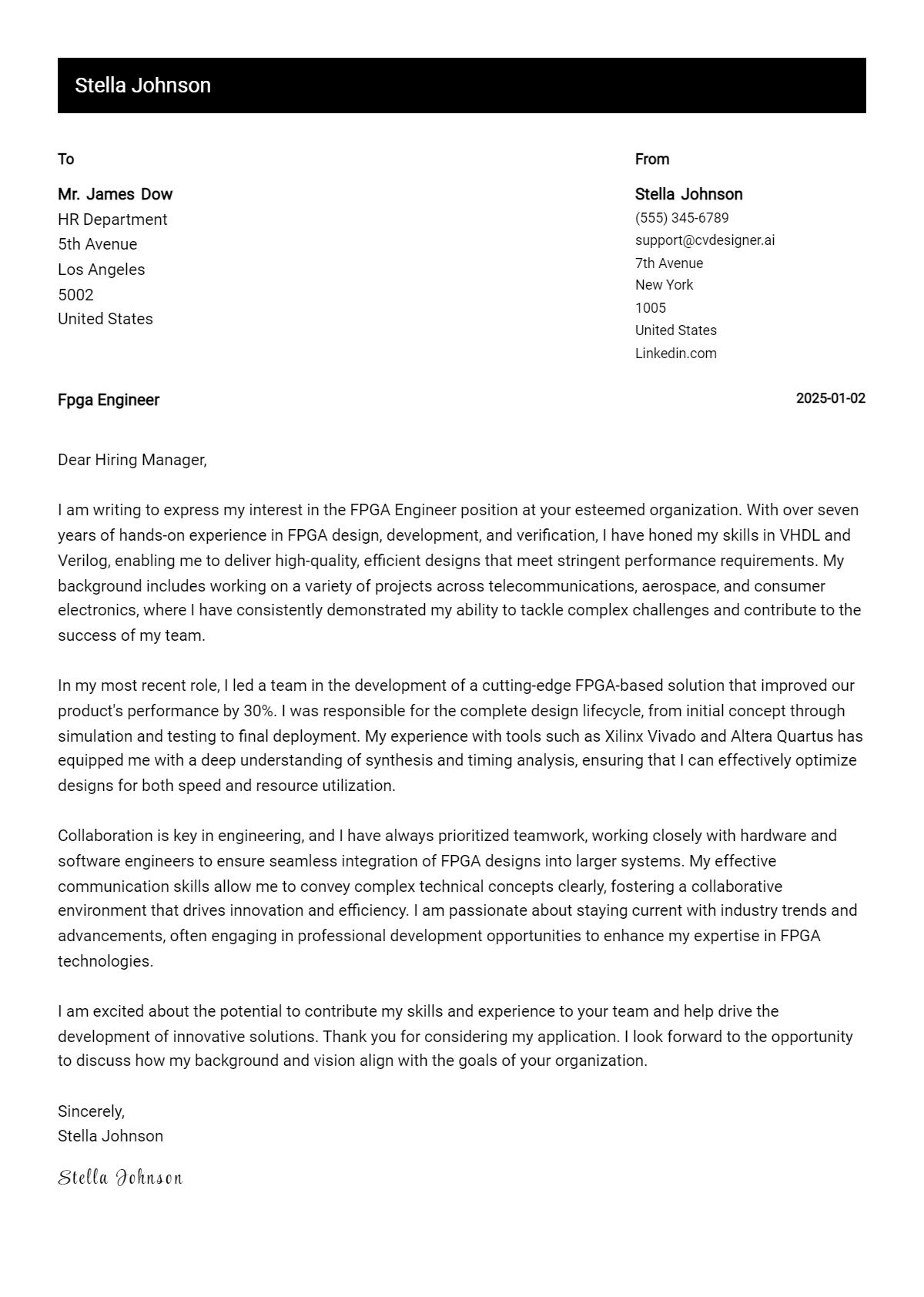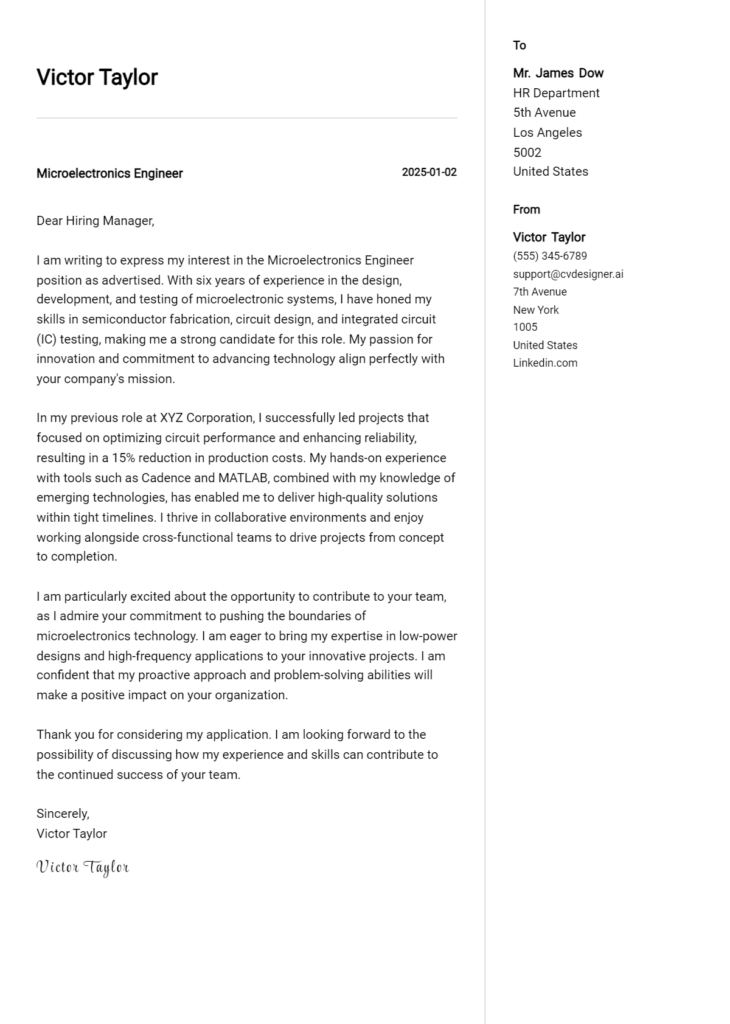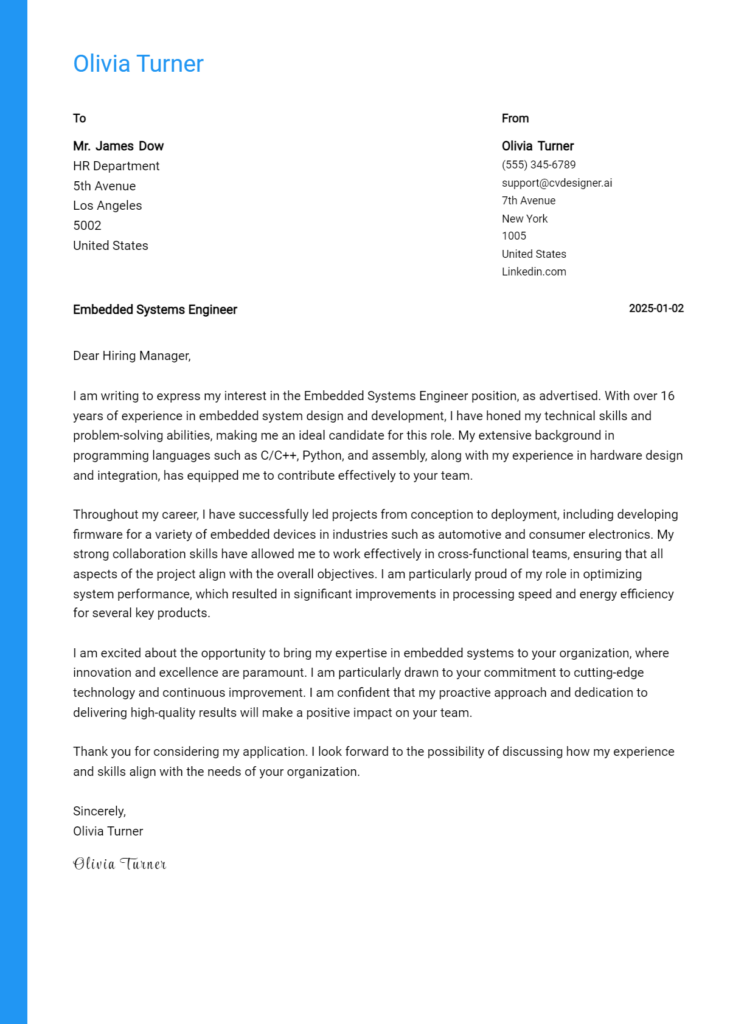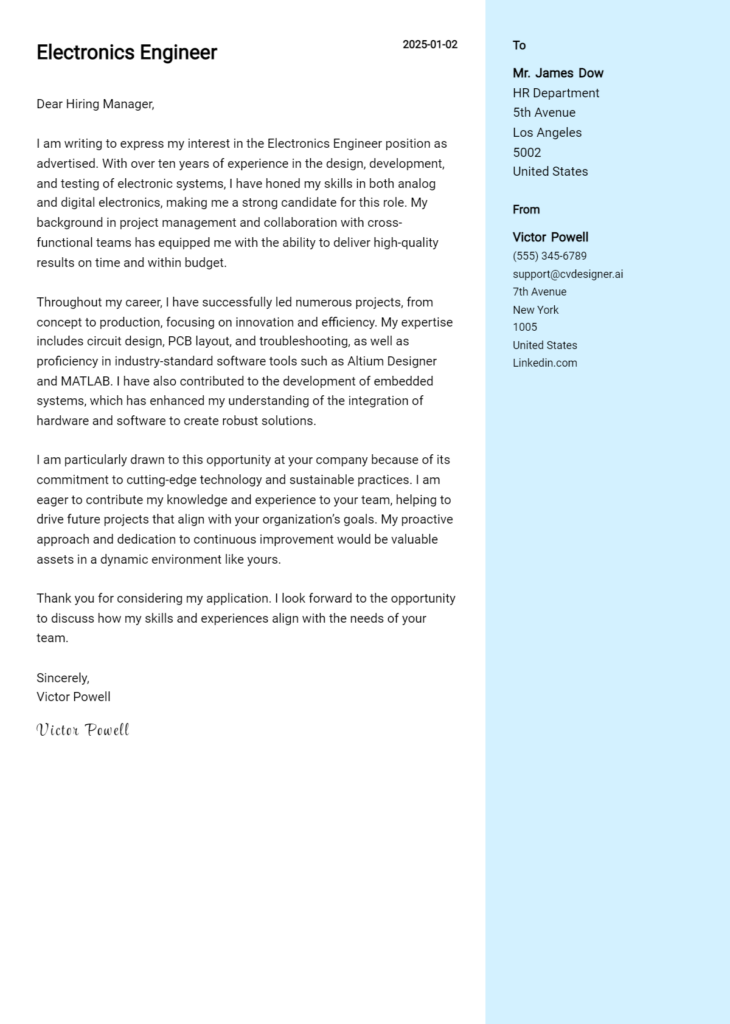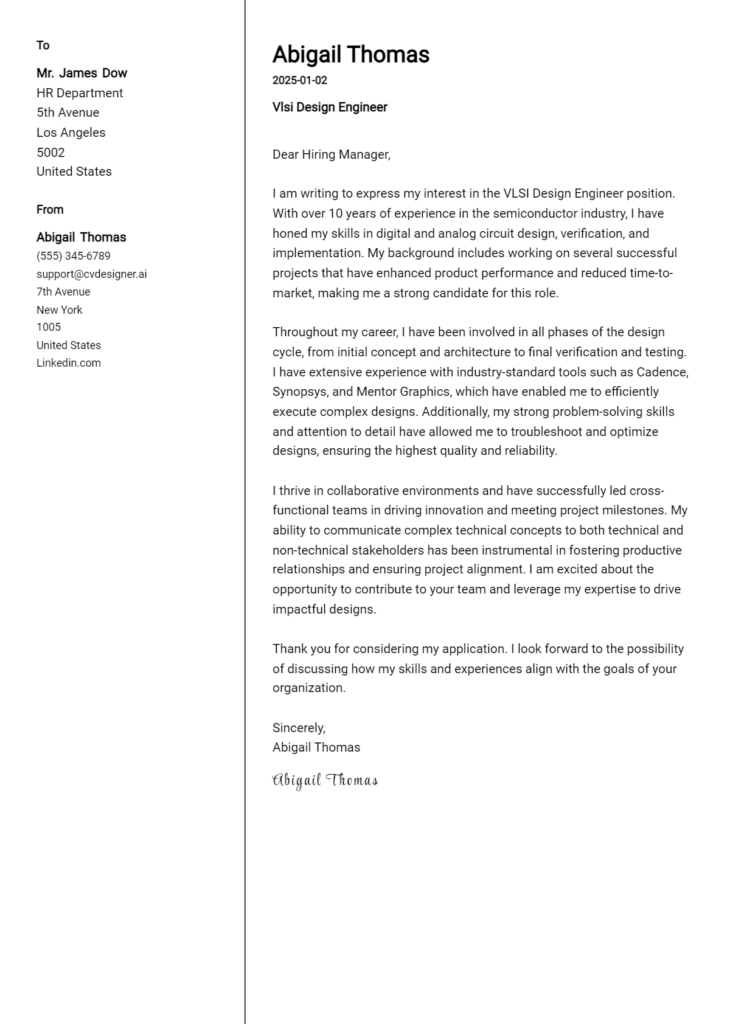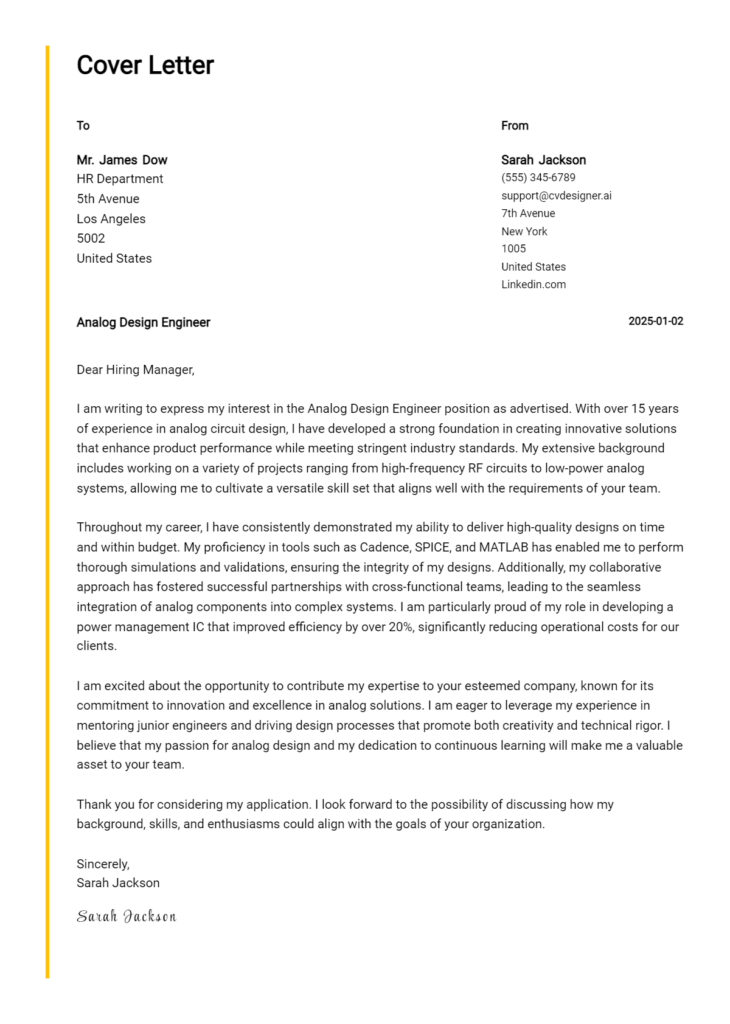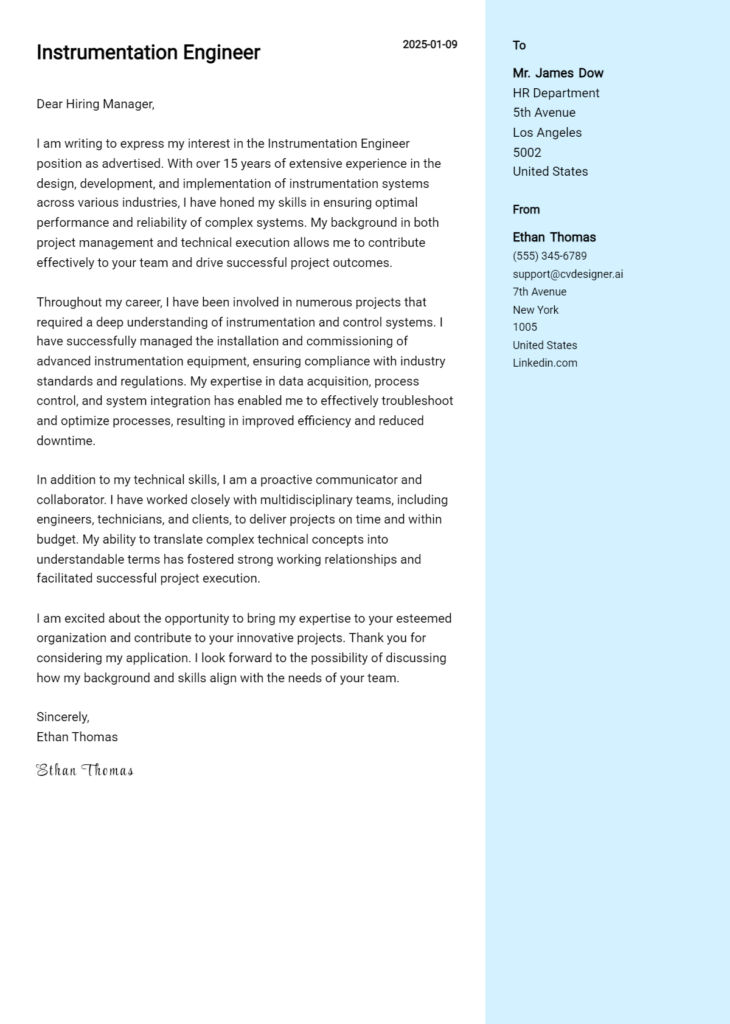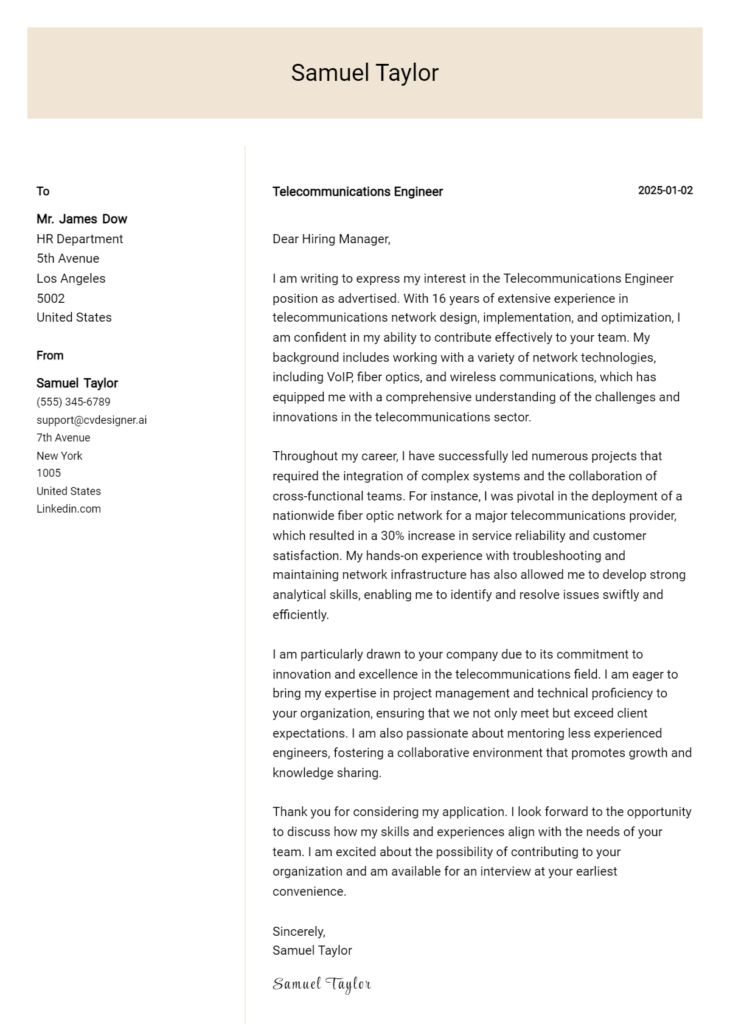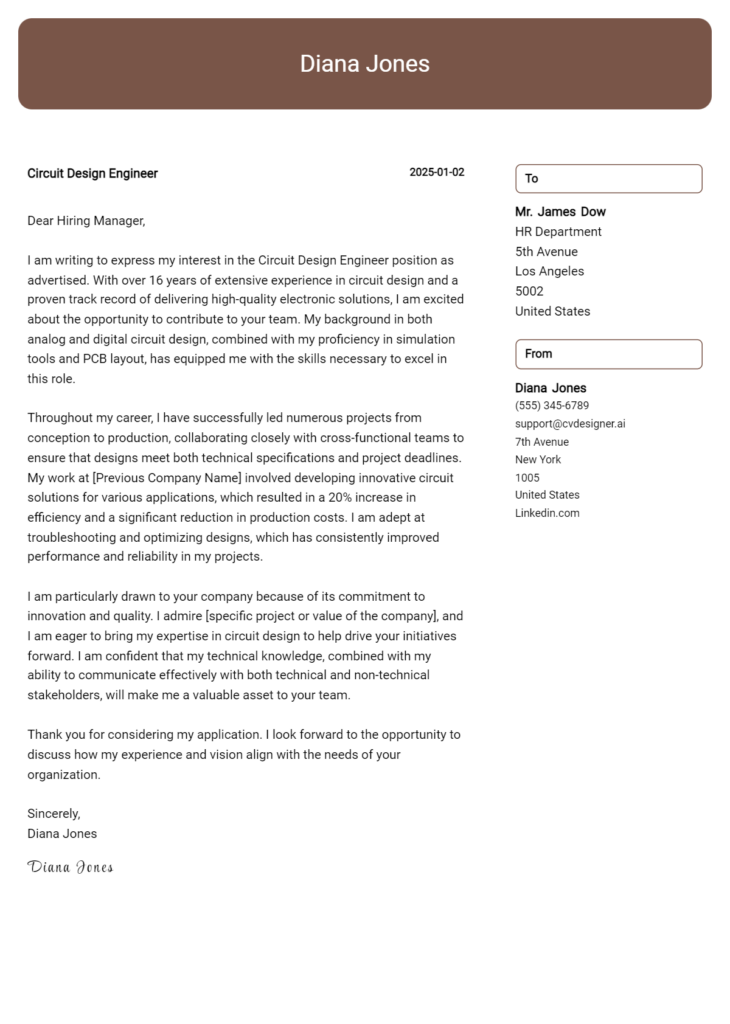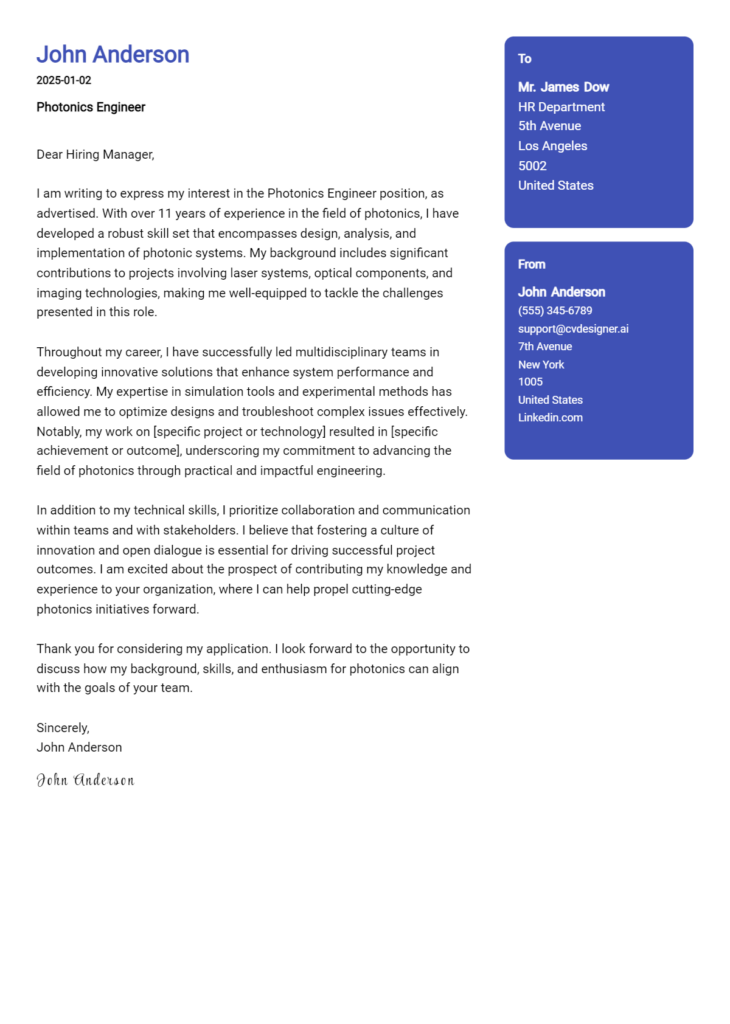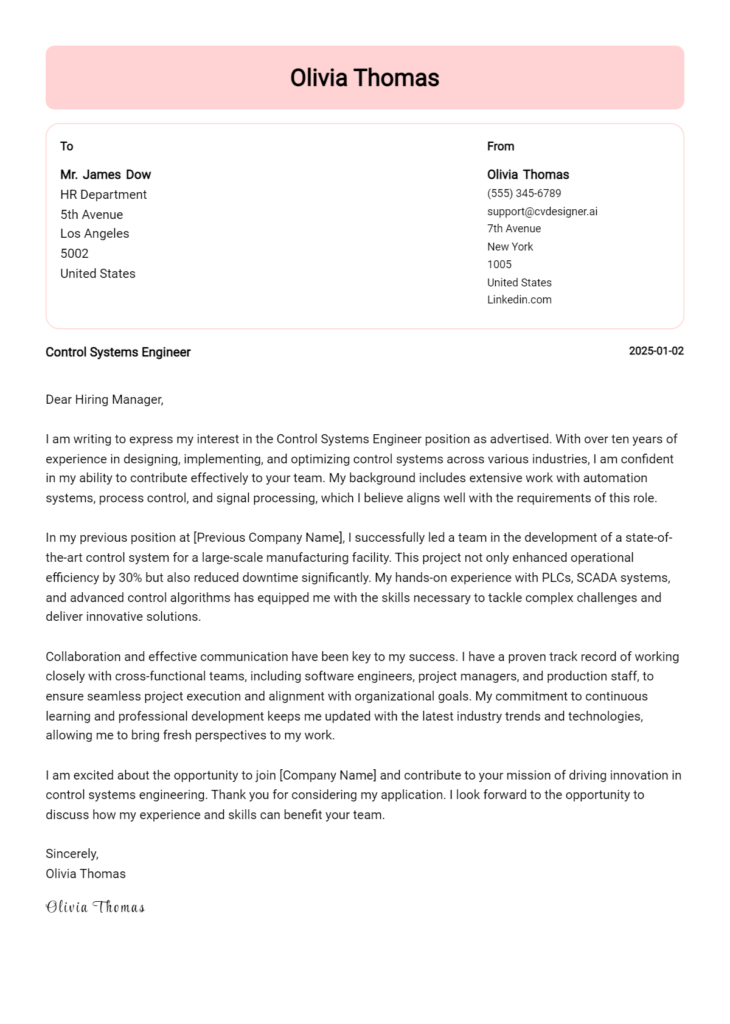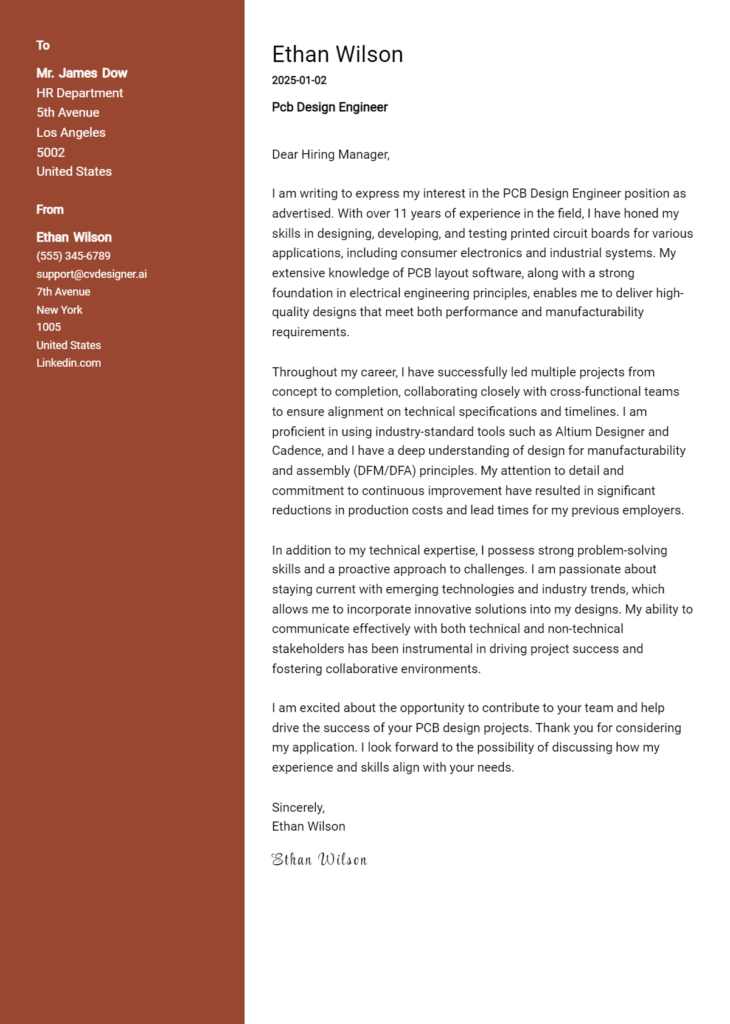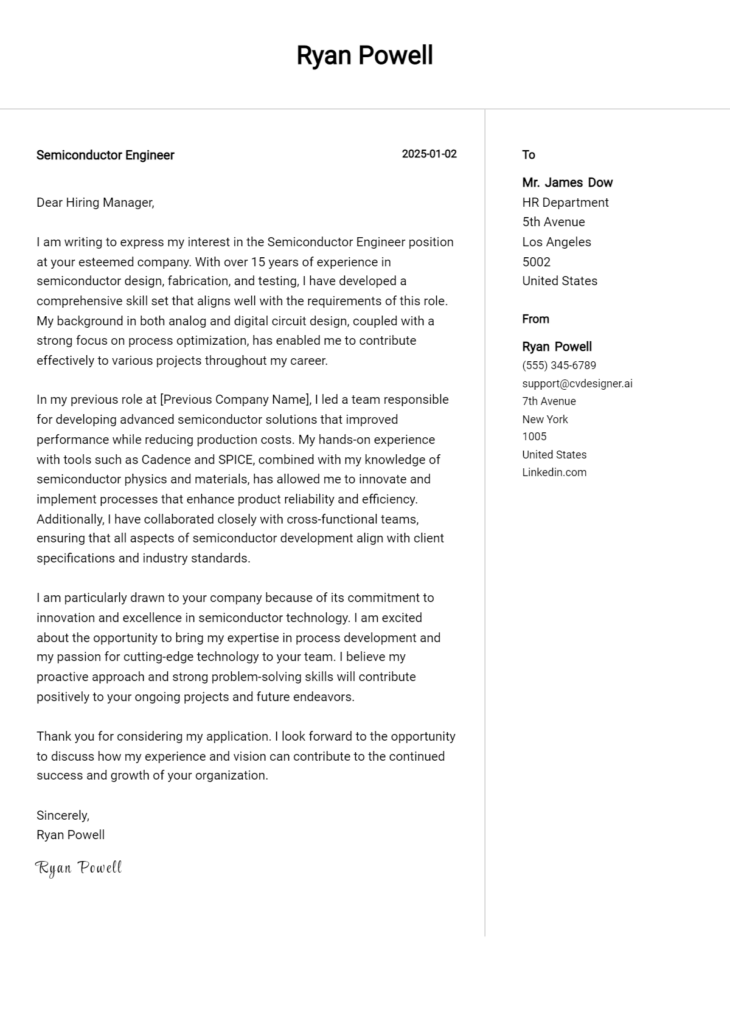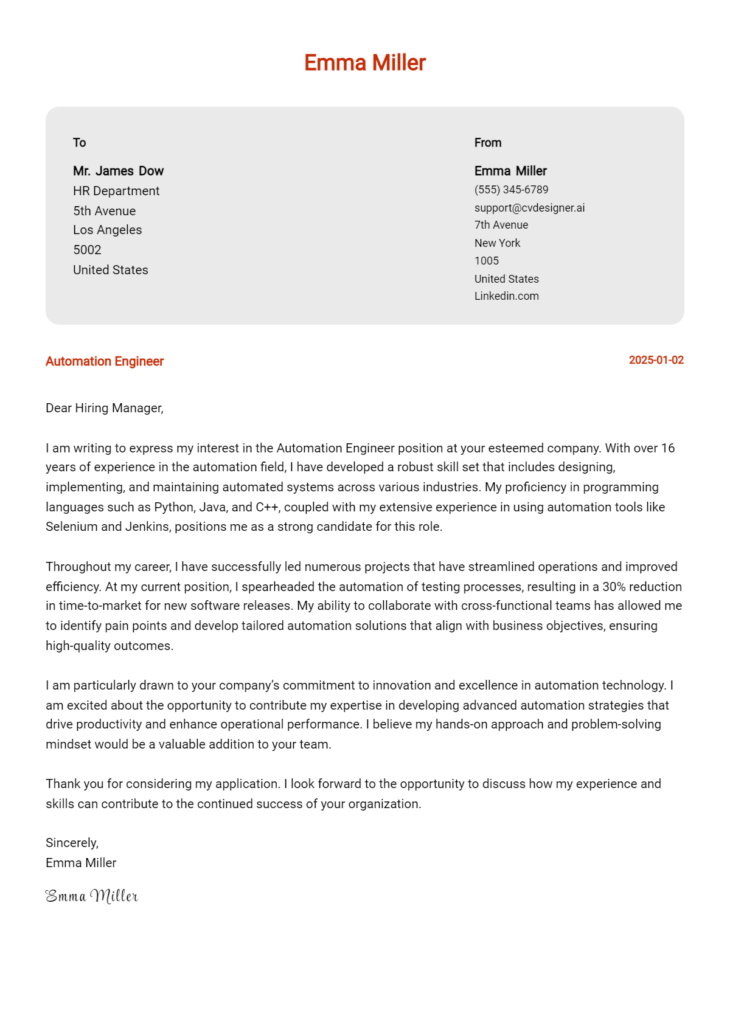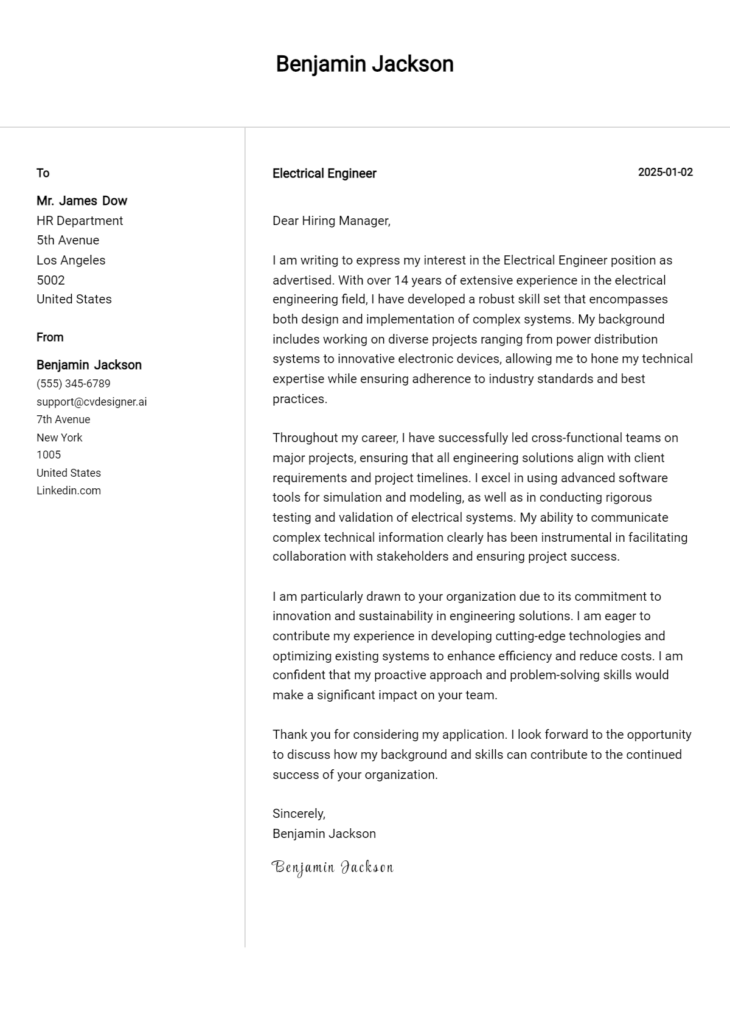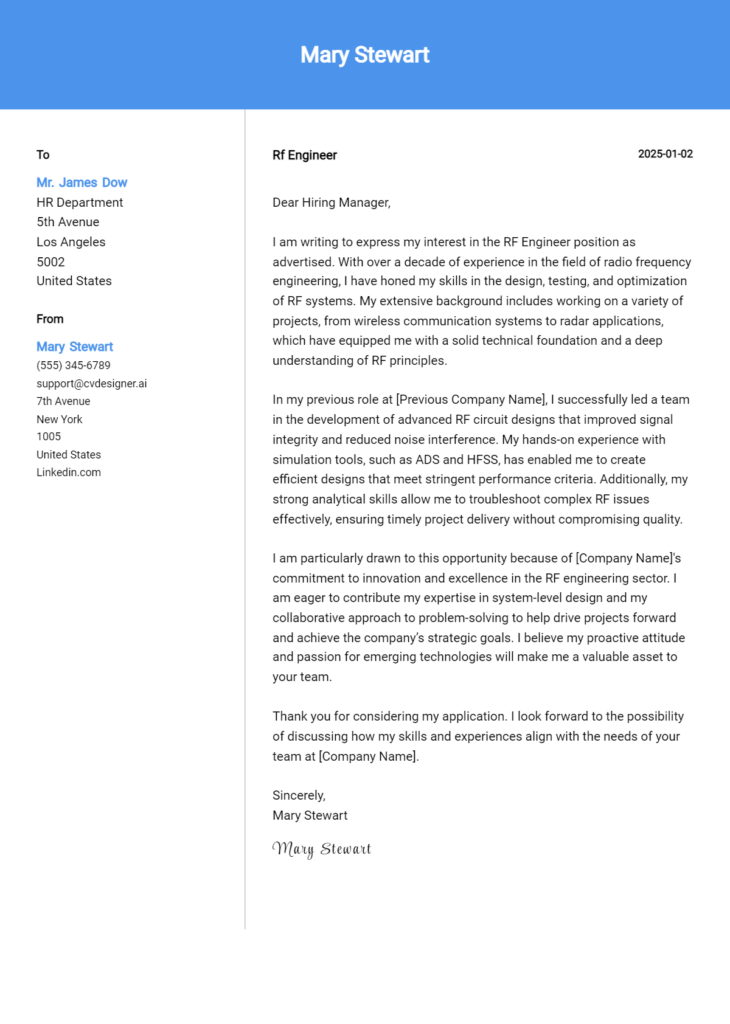Fpga Engineer Cover Letter Examples
Explore additional Fpga Engineer cover letter samples and guides and see what works for your level of experience or role.
How to Format an FPGA Engineer Cover Letter
Crafting an effective cover letter as an FPGA Engineer is crucial, as it serves as your first opportunity to display not only your technical expertise but also your attention to detail and problem-solving abilities. The format of your cover letter can significantly impact how your qualifications are perceived, mirroring the precision and systematic approach needed in FPGA design and development. A well-structured cover letter captures the hiring manager's interest and sets the tone for your application, reflecting the meticulous nature of your work.
In this guide, we'll outline how to structure your cover letter, providing insights and FPGA-specific examples to help you create an impactful document.
We will focus on the essential components of a professional cover letter, including:
- Cover Letter Header
- Cover Letter Greeting
- Cover Letter Introduction
- Cover Letter Body
- Cover Letter Closing
Each section is integral to effectively showcasing your qualifications and professionalism. Let’s explore each part and learn how to make your FPGA Engineer cover letter shine.
Importance of the Cover Letter Header for an FPGA Engineer
The cover letter header is a critical component of your application as an FPGA Engineer. It serves as the first impression you make on a potential employer, setting the tone for the rest of your letter. A well-structured header not only conveys professionalism but also ensures that your contact information is easily accessible. The header should include your name, address, phone number, email address, the date, and the recipient's details (name, title, company, and address). Clarity and professionalism in this section are paramount, as they reflect your attention to detail—an essential quality in the field of FPGA design.
Strong Example
John Doe 1234 FPGA Lane Tech City, CA 90210 (123) 456-7890 john.doe@email.com October 1, 2023 Jane Smith Hiring Manager Innovative Designs Inc. 5678 Circuit Road Tech City, CA 90211
Weak Example
jd123@xyz.com Oct 1, 2023 Jane S. Innovative Designs
The Importance of the Cover Letter Greeting for an FPGA Engineer
The greeting of your cover letter serves as the first impression to a hiring manager, setting the tone for the rest of your application. A well-crafted greeting demonstrates professionalism and shows that you have taken the time to personalize your communication, which can significantly impact your chances of making a positive impression. Addressing the hiring manager directly can create a connection and indicate your genuine interest in the position. To enhance the effectiveness of your greeting, avoid generic salutations such as "To Whom It May Concern." Instead, invest some time in researching the recipient's name and title, which can often be found on the company’s website or through professional networking platforms.
Strong Greeting Example
Dear Dr. Smith,
Weak Greeting Example
To Whom It May Concern,
The Importance of a Well-Crafted Cover Letter Introduction for an FPGA Engineer
A well-crafted cover letter introduction is crucial for an FPGA Engineer, as it serves as the first impression for the hiring manager. This opening paragraph should not only capture attention but also convey the candidate’s enthusiasm for the role. It’s an opportunity to briefly highlight relevant skills, experiences, or achievements that align with the job requirements. A strong introduction sets the tone for the entire cover letter and can significantly enhance the chances of securing an interview. Below are examples of both effective and ineffective cover letter introductions for an FPGA Engineer position.
Strong Example
Dear Hiring Manager, As a passionate FPGA Engineer with over five years of experience in designing and implementing complex digital circuits, I was thrilled to discover the opening at [Company Name]. My expertise in VHDL and Verilog, combined with a proven track record of delivering high-performance solutions for critical applications, positions me as a strong candidate for this role. I am eager to bring my technical skills and innovative mindset to your team, contributing to cutting-edge projects that push the boundaries of technology.
Weak Example
To whom it may concern, I am writing to apply for the FPGA Engineer position. I have some experience in this field and think I could do the job. My resume is attached for your reference.
Purpose of the Cover Letter Body for an FPGA Engineer
The cover letter body for an FPGA Engineer serves as a critical opportunity to present the candidate's technical skills, relevant experiences, and the unique value they bring to the prospective employer. This section should effectively highlight specific projects or accomplishments that demonstrate the candidate's expertise in FPGA design and development, as well as their problem-solving abilities and innovation in previous roles. By detailing these experiences, the candidate can create a compelling narrative that aligns their qualifications with the needs of the company, showcasing their potential to contribute to future projects.
Strong Example
Dear Hiring Manager, I am excited to apply for the FPGA Engineer position at XYZ Corporation. In my previous role at ABC Technologies, I led a team of engineers in the design and implementation of a high-performance FPGA-based image processing system that improved processing speeds by 30%. This project not only enhanced the capabilities of our product line but also resulted in a 15% increase in client satisfaction scores. My proficiency in VHDL and Verilog, combined with my hands-on experience in simulation and hardware debugging, positions me well to contribute effectively to your team. Additionally, my recent certification in advanced FPGA design principles has equipped me with the latest industry knowledge, further enhancing my ability to deliver innovative solutions. Sincerely, [Your Name]
Weak Example
Dear Hiring Manager, I want to apply for the FPGA Engineer job. I have done some work with FPGAs before. I can write code in VHDL and Verilog. I believe I would be a good fit for your company. I have completed some projects, but I can't remember all the details right now. I am looking forward to the opportunity. Best, [Your Name]
Importance of the Cover Letter Closing for an FPGA Engineer
The closing paragraph of a cover letter is crucial as it serves to summarize qualifications, reiterate enthusiasm for the role, and encourage the hiring manager to take the next steps, such as reviewing the resume or scheduling an interview. A strong closing leaves a lasting impression, reinforcing the candidate's fit for the position and demonstrating a proactive attitude. In contrast, a weak closing may fail to convey the applicant's excitement or may not effectively prompt the employer to act on the application.
Strong Example
Thank you for considering my application for the FPGA Engineer position. With a solid background in digital design and a passion for developing innovative FPGA solutions, I am excited about the opportunity to contribute to your team. I believe my skills in VHDL, system integration, and problem-solving uniquely qualify me for this role. I look forward to discussing how I can bring my expertise to your projects and help drive success at [Company Name]. Please feel free to contact me to schedule an interview at your earliest convenience.
Weak Example
Thanks for reading my letter. I hope you think about my resume. I guess we can talk more if you're interested.
Crafting an effective cover letter is essential for FPGA Engineer candidates looking to stand out in a competitive job market. A well-written cover letter not only highlights your technical skills but also demonstrates your problem-solving abilities, knowledge of the Software Development Life Cycle (SDLC), teamwork experience, and a commitment to continuous learning. These elements are critical in showcasing your fit for the role and your potential to contribute to a company's success. Here are some tips to help you create a compelling cover letter:
Tips for Writing a Cover Letter as an FPGA Engineer
Highlight Relevant Technical Skills
Make sure to specifically mention your proficiency in FPGA design tools, programming languages (like VHDL or Verilog), and simulation software. Tailor your skills to match the job description, emphasizing any unique expertise that aligns with the company’s projects. This targeted approach demonstrates your technical capabilities and shows you’ve done your homework.Showcase Problem-Solving Abilities
Employers value engineers who can tackle complex challenges. Include a brief example of a problem you faced in a previous project and describe how you approached it, the solution you implemented, and the outcome. This not only highlights your analytical skills but also illustrates your ability to think critically under pressure.Demonstrate Knowledge of the SDLC
Familiarity with the Software Development Life Cycle is vital for any role involving embedded systems and FPGA development. Discuss your experience with different phases of the SDLC, such as requirements analysis, design, implementation, testing, and maintenance. This can reassure potential employers of your understanding of the full development process.Emphasize Teamwork and Collaboration
FPGA projects often require collaboration with cross-functional teams. Illustrate your ability to work effectively in a team setting by sharing experiences where you contributed to group projects. Mention any roles you’ve played in team dynamics, such as leading initiatives or mentoring junior engineers, to highlight your interpersonal skills.Convey a Passion for Continuous Learning
The field of FPGA engineering is constantly evolving with new technologies and methodologies. Express your enthusiasm for learning by mentioning any relevant certifications, workshops, or courses you've undertaken. This demonstrates your commitment to staying current in the field and your proactive approach to professional development.
By incorporating these tips into your cover letter, you'll be better positioned to impress potential employers. For further assistance, consider utilizing cover letter templates or a cover letter builder to streamline your writing process and create a polished final product.
Common Mistakes to Avoid in a FPGA Engineer Cover Letter
Crafting a compelling cover letter is essential for standing out in the competitive field of FPGA engineering. Avoiding common mistakes can significantly enhance your chances of landing an interview. Here are some frequent pitfalls to watch out for:
Generic Content: Failing to customize your cover letter can make it blend into the pile. Tailor your letter to the specific job by mentioning the company and its projects.
Lack of Technical Skills: Omitting relevant technical proficiencies can be detrimental. Clearly highlight your experience with VHDL, Verilog, and simulation tools to demonstrate your qualifications.
Ignoring Formatting: A poorly formatted cover letter can distract from your message. Adhere to cover letter format guidelines to ensure clarity and professionalism.
Typos and Grammatical Errors: Small mistakes can undermine your credibility. Always proofread your letter or use tools to catch errors before submission.
Not Demonstrating Passion: Failing to convey enthusiasm for the role can make your application seem lackluster. Share why you are passionate about FPGA design and how it aligns with your career goals.
Overly Lengthy or Vague Statements: Being too verbose can lose the reader's attention. Keep your letter concise and focused, providing specific examples of your achievements.
Neglecting to Include a Call to Action: Forgetting to invite further discussion can leave your application hanging. End your letter by expressing your eagerness to discuss your qualifications in an interview.
For inspiration, refer to various cover letter examples to see how to effectively present your skills and experiences.
Cover Letter FAQs for FPGA Engineer
What should I include in my cover letter as an FPGA Engineer?
In your cover letter, begin with a strong introduction that states the position you are applying for and where you found the job listing. Highlight your relevant experience in FPGA design, development, and verification, emphasizing specific projects you’ve worked on, such as using VHDL or Verilog. Include any experience with simulation tools like ModelSim or Xilinx ISE, as well as your familiarity with hardware description languages. Additionally, mention soft skills such as problem-solving and teamwork. Tailor your letter to the company's needs by aligning your skills with the job description, showcasing how you can contribute to their projects and goals.
How can I demonstrate my technical skills in my cover letter?
Demonstrating technical skills in your cover letter involves providing specific examples of your previous work. Discuss projects where you successfully implemented FPGA solutions, detailing the technologies and methodologies used. For instance, mention any complex designs you’ve developed, optimizations you executed, or challenges you overcame during the design cycle. Highlight your proficiency with specific tools like Quartus or Vivado and any relevant certifications or training you've received. You can also reference performance metrics that showcase the success of your designs, such as improvements in speed or efficiency. This not only illustrates your technical expertise but also shows your ability to deliver tangible results.
Should I include my education and certifications in my cover letter?
Yes, including your education and certifications in your cover letter is important. Start by mentioning your degree in Electrical Engineering or a related field, and highlight any specialized coursework in digital design or FPGA architecture. If you hold certifications such as Xilinx Certified FPGA Designer or similar credentials, be sure to include them as they validate your expertise. While your resume will provide detailed information, your cover letter should summarize these qualifications concisely, demonstrating your educational background's relevance to the FPGA Engineer role. This helps to establish your credibility and reinforces your qualifications for the position.
How do I tailor my cover letter for a specific FPGA Engineer job?
To tailor your cover letter for a specific FPGA Engineer job, carefully read the job description and identify key skills and experiences the employer emphasizes. Mention these elements directly in your cover letter, using specific examples from your background that align with their requirements. Research the company’s projects, culture, and technology stack, and integrate this information into your letter to demonstrate your genuine interest. For instance, if the company specializes in automotive applications, highlight your experience in that sector. Customizing your letter not only shows your enthusiasm for the position but also illustrates that you understand the company’s needs and are prepared to meet them.
Build your Cover Letter in minutes
Use an AI-powered cover letter builder and have your letter done in 5 minutes. Just select your template and our software will guide you through the process.

